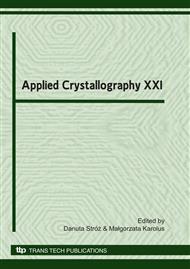p.165
p.169
p.173
p.177
p.183
p.187
p.191
p.195
p.200
The Structure and Mechanical Properties of Al-7%SiMg Alloy Treated with a Homogeneous Modifier
Abstract:
Results of studies on the modification of Al-7%SiMg alloy with a homogeneous modifier obtained by fast cooling of homogeneous modifiers at V=200 K/s are presented in the paper. Homogeneous modifiers are additions designed for modification of the alloys from which they were obtained at 0, 7, 12 and 20% Si. The components were put into a crucible containing liquid Al-Si alloy and kept there for one minute. The effects of cooling rate and w/w concentration of the modifier in the melt on structure and tensile strength, percentage elongation, Brinell hardness, abrasive wear are illustrated graphically. The analysis of the process of hypo-eutectic Al-Si alloy modification with a homogeneous modifier obtained from treated alloy by fast cooling shows that this modifying addition affected structural,physical and mechanical properties of Al-7%SiMg alloy.
Info:
Periodical:
Pages:
183-186
Citation:
Online since:
June 2010
Authors:
Keywords:
Price:
Сopyright:
© 2010 Trans Tech Publications Ltd. All Rights Reserved
Share:
Citation:


